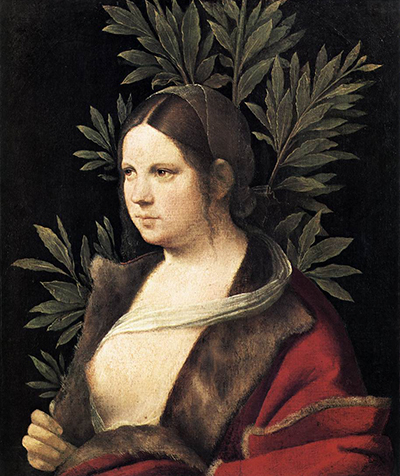Laura is a portrait of a young dark-haired woman by Giorgione, an Italian renaissance artist. The portrait drapes in Kunsthistorisches, one of the most visited art museums in Vienna, Austria.
Although there have been many intriguing debates on whether the figure in the image is a courtesan or a bride, the museum holds that the painting is a representation of a young bride called Laura di Noves. The portrait bears a date confirming that Giorgione finished the painting on June 1, 1506. Perhaps, this is the only artwork by Giorgione that is dated.
Laura is painted using an old technique of oil on canvas. Over the centuries, the picture has been changed into different shapes. It was first transposed into an oval shape and later reinstated into a rectangle. Before the alteration, the picture used to extend below the waist with ample space at the top. Currently, it measures 41cm by 33.6 cm. Behind the bride is a branch of a laurel tree. Many theories trying to explain the picture revolve around this branch. Despite the different views, a majority of the theories agree that the painting is a symbol of chastity and fidelity. Such paintings were quite common in portraits of wedded and dating couples.
From the image, the woman is pictured opening her fur cloak to expose her bosom, something that clears the way for two different interpretations. Firstly, it can be inferred as a seduction towards a male viewer or simply an offer of love. Secondly, the bare breast could be a symbol of a woman’s marital fidelity and a blessed marriage. The laurel in the back is a pinnacle of poets and a symbol of virtue. In this painting, Giorgione utilizes soft colors with elegant transitions from one palette to another. The use of soft fur and delicate veil on a fair skin tone is a display of sensuality.
Others have it that the cloak worn by the bride belongs to a man which further suggests a bedroom scene, and from this perspective, the audience can quickly presume that the woman portrays an indefinable expression to whoever she is staring at. Moreover, the painting can be ascribed to be undisputable because of its long and well-documented origin. This portrait is not uncommon from Ginevra de’ Benci, one of Leonardo’s best arts that he created when was indentured to Andrea Verrocchio.
The whole technique behind the softening of the silhouettes is an inspiration that Giorgione acquired from Leonardo. Further, the signing at the back of the portrait shows that the picture belongs to Archduke Leopold Wilhelm's collections which are currently displayed in Prado, Madrid.




